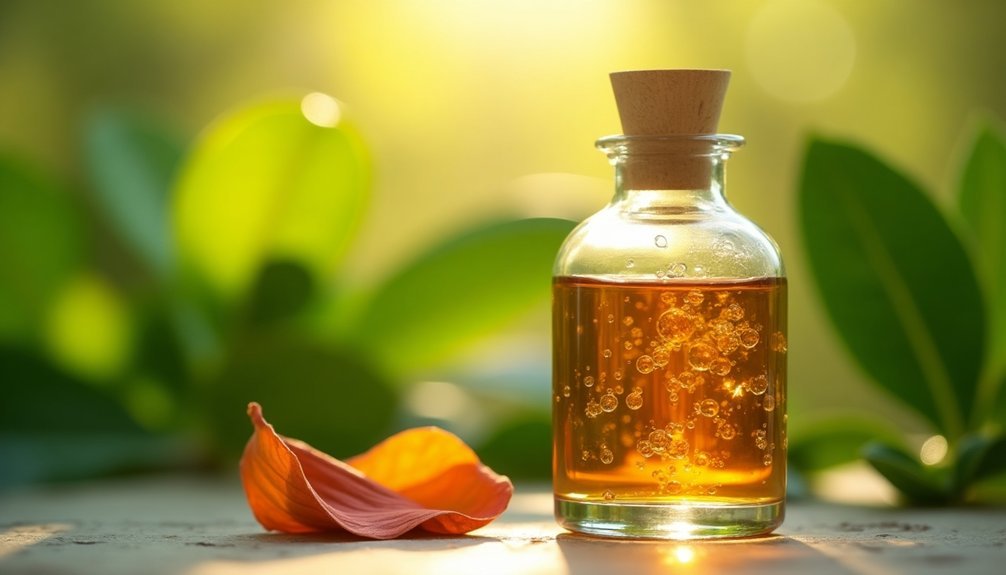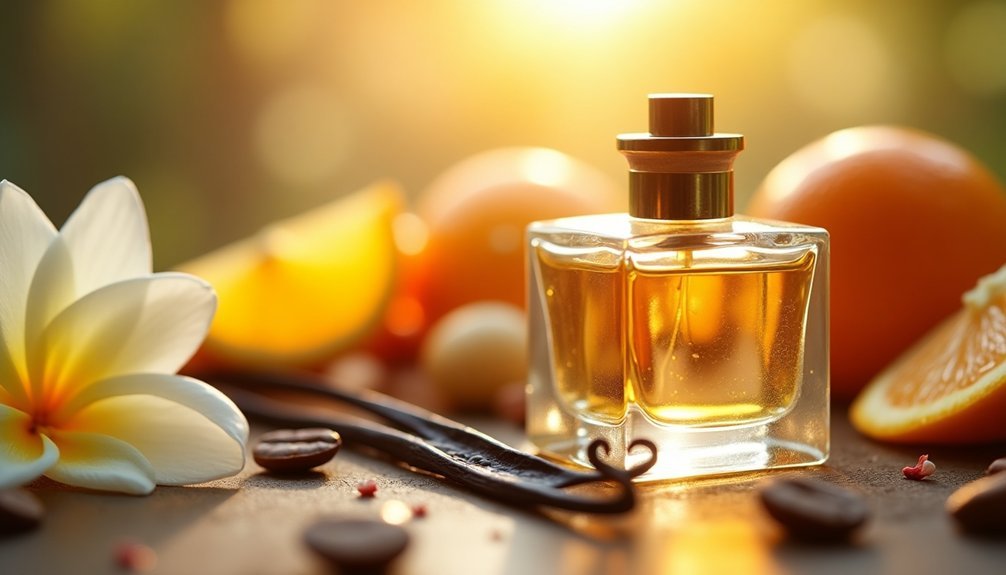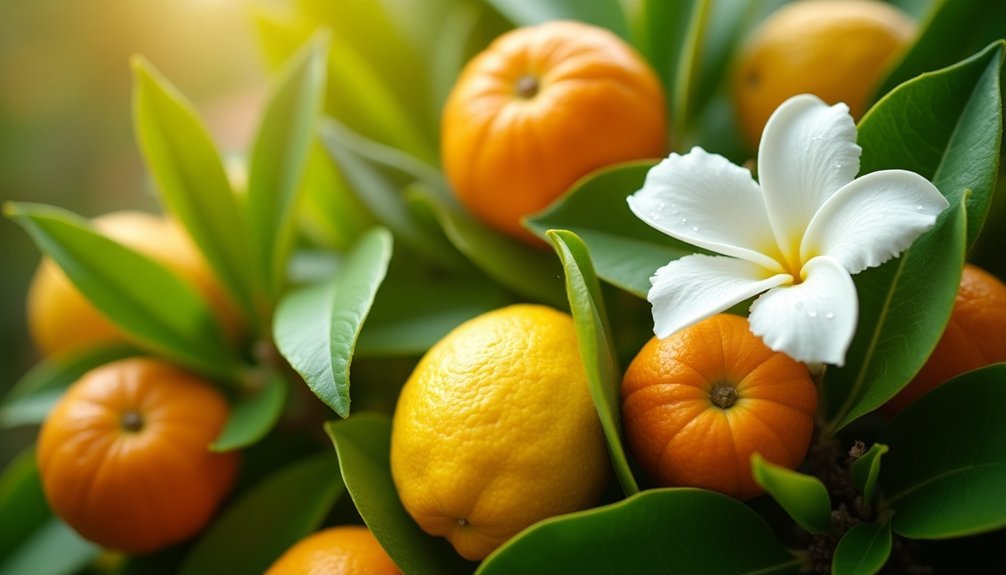Your botanical perfumes turn brown due to oxidation when fragrance compounds react with oxygen, light, and heat. Certain ingredients like vanillin, citrus oils, and floral notes are especially prone to discoloration. You can prevent spoilage by storing fragrances in dark glass bottles at cool temperatures (41-65°F) away from sunlight and humidity. Proper storage techniques and natural preservatives offer effective solutions to keep your precious botanicals fresh and vibrant.
The Science Behind Natural Perfume Discoloration

While botanical perfumes offer natural fragrance alternatives, they're prone to discoloration through various chemical processes. When your perfume turns brown, oxidation is usually the main culprit. As you use your fragrance, the increased air space in the bottle allows oxygen to react with aromatic compounds, gradually altering their chemical structure and color.
Light exposure intensifies this process, as UV rays break down chemical bonds in your perfume's ingredients. Heat further accelerates these reactions, making temperature control essential for preservation. Consistent exposure to high humidity levels can destabilize the fragrance compounds and accelerate deterioration.
You'll notice this particularly in formulations containing vanillin or citrus oils, which are especially susceptible to oxidation.
To protect your botanical perfumes, you'll want to store them in dark, opaque bottles, keep them tightly sealed, and maintain a cool storage environment. These practices will notably slow down the discoloration process.
Key Ingredients That Trigger Color Changes
Understanding which ingredients cause color changes in botanical perfumes helps you prevent unwanted discoloration. The most reactive components are vanillin, citrus oils, and certain floral extracts like rose and jasmine. These ingredients are particularly vulnerable to oxidation and environmental factors, leading to noticeable color shifts in your perfume.
- Citrus and floral notes are highly susceptible to UV light exposure, causing them to bleach or darken.
- Vanillin and essential oils react strongly with heat and humidity, accelerating discoloration. The organic sunflower seed oil base used in botanical perfumes can also oxidize when exposed to light and heat.
- Complex reactions between aldehydes and methyl anthranilate form deep-colored Schiff's bases.
- Metal contamination and environmental factors can trigger unwanted reactions in rose and jasmine oils.
Watch out for these ingredients when selecting or storing your botanical perfumes, as they'll greatly impact the longevity and appearance of your fragrance.
Storage Methods to Prevent Oxidation

To preserve the integrity of your botanical perfumes, proper storage methods are essential for preventing oxidation and maintaining their original scent profiles.
Store your fragrances in a cool, dark place at around 41 degrees Fahrenheit, away from direct sunlight and temperature fluctuations. A refrigerator or cabinet in a closet works well, but avoid bathrooms due to humidity.
Keep your perfumes in their original glass bottles with tight-fitting caps, as they provide the best protection against air and light exposure. Using opaque storage containers provides additional oxidation protection for your valuable fragrances.
Don't transfer your fragrances to decorative bottles that aren't airtight. When using your perfume, open the bottle briefly and avoid shaking it vigorously – instead, give it a gentle swirl.
Remember to store bottles away from metal surfaces, which can react with the fragrance and alter its composition.
Essential Oils and Their Aging Process
When storing your botanical perfumes, you'll notice natural essential oils change color over time, with some becoming darker or more yellow due to oxidation and environmental factors.
Unlike their synthetic counterparts, which maintain relatively stable properties, natural essential oils are more susceptible to degradation through exposure to light, heat, and oxygen.
You'll get the best longevity from your natural essential oils by storing them at cool temperatures between 35-40°F (2-4°C), as higher temperatures accelerate the aging process and chemical changes.
Color Changes Over Time
Color changes in essential oils serve as important indicators of their aging process and quality. You'll notice these changes occurring due to various factors, primarily oxidation and exposure to light or temperature fluctuations.
When essential oils age, they can darken, lighten, or become cloudy, especially in citrus-based formulations.
- Oxidation happens naturally when oils interact with air, causing molecular changes that affect both color and scent.
- Light exposure accelerates degradation, which is why dark glass bottles are vital for storage.
- Temperature changes destabilize the oil's chemical structure, leading to visible alterations.
- Certain ingredients, like vanillin and citrus compounds, are particularly prone to discoloration.
To protect your oils, store them in cool, dark places and use airtight containers.
Regular inspections will help you catch any concerning changes early.
Natural Vs Synthetic Stability
Understanding the aging differences between natural and synthetic perfumes builds on our knowledge of color changes in botanical fragrances. You'll notice that natural ingredients create an ever-evolving scent profile, while synthetic ones maintain a static character.
| Characteristic | Natural | Synthetic |
|---|---|---|
| Shelf Life | 1-2 years | 5+ years |
| Scent Profile | Dynamic, evolving | Linear, static |
| Environmental Impact | Sensitive to light, air | Highly stable |
| Consistency | Varies by harvest | Uniform |
While synthetic fragrances offer predictability and longevity, they can lead to nose fatigue. Natural perfumes, though shorter-lived, provide a complex journey enriched by essential oils' beneficial properties. These oils not only contribute to the fragrance but also offer antioxidant protection and skin-nurturing benefits, making them an integral part of botanical perfume stability.
Storage Temperature Effects
Temperature plays a vital role in preserving the integrity of essential oils used in botanical perfumes. While cold temperatures won't harm your oils, heat can greatly accelerate their degradation. When exposed to temperatures above 100°F (38°C), particularly citrus oils and absolutes begin to break down, causing their volatile components to separate and evaporate.
- Citrus oils like Bergamot and Lemon are especially vulnerable to heat damage above 100°F.
- Jasmine and other absolutes can degrade at temperatures as low as 90°F.
- Cold storage (even freezing) won't harm your oils and can extend their shelf life.
- Heat speeds up chemical reactions, making oils more volatile and causing faster aging.
To protect your botanical perfumes, store them in dark glass or aluminum bottles at room temperature or slightly cooler, away from direct light and heat sources.
Natural Preservatives for Extended Shelf Life

When crafting botanical perfumes, selecting the right natural preservatives is crucial for maintaining product safety and extending shelf life.
You'll need to choose preservatives that match your perfume's base, whether water-soluble options like OptiphenTM BSB-W for aqueous formulations or oil-compatible alternatives.
To maximize protection, combine preservatives with natural boosters like glyceryl caprylate, which helps destabilize microbial cell membranes.
Consider using antioxidants such as vitamin E or rosemary extract to prevent oxidation and combat rancidity.
Common natural preservatives include benzyl alcohol, sorbic acid, and salicylic acid, which offer broad-spectrum protection against microorganisms.
Store your preserved perfumes in airtight containers away from light, heat, and humidity.
Always follow recommended usage levels and verify your chosen preservatives are certified by organizations like ECOCERT or COSMOS for natural compliance.
Best Practices for Botanical Blend Stability
You'll maximize your botanical perfume's longevity by storing it at consistent temperatures between 35-65°F and keeping it away from direct sunlight in dark glass bottles.
To further protect your blend's stability, incorporate natural preservatives like vitamin E oil, rosemary extract, or benzoin resin.
Your attention to these preservation methods, combined with proper storage practices, can extend your perfume's shelf life from several months to over a year.
Storage Temperature Controls Oxidation
Proper storage temperature plays an essential role in maintaining the integrity of botanical perfumes, as it directly controls the rate of oxidation and molecular breakdown.
You'll want to keep your fragrances at a steady 60-70°F (15-21°C) to prevent unwanted chemical reactions that can alter their scent and performance.
- Heat above 90°F accelerates oxidation and evaporation of volatile molecules, causing your perfume's aroma to change.
- Cold temperatures help stabilize fragrance compounds, but avoid freezing as it can damage certain ingredients.
- Store bottles away from direct sunlight, heaters, and radiators to prevent premature deterioration.
- Consider using climate-controlled storage or refrigeration with proper moisture protection for long-term preservation.
Don't keep your perfumes in bathrooms or areas with temperature fluctuations, as these conditions can greatly reduce their shelf life.
Minimize UV Light Contact
To protect the delicate compounds in botanical perfumes, minimizing UV light exposure is essential for maintaining their stability and preventing adverse skin reactions. Many natural ingredients, especially citrus oils and lavender, can trigger photo-allergic responses when exposed to sunlight, leading to irritation and hyperpigmentation.
| Ingredient Type | UV Safety Practice |
|---|---|
| Citrus Oils | Apply under clothing |
| Lavender | Use as hair mist |
| Sandalwood | Spray on fabric |
| Essential Oils | Choose covered areas |
You'll want to apply your botanical perfumes to areas that don't receive direct sunlight, such as under clothing or hair. Consider using your fragrances on scarves or clothing instead of skin, particularly if they contain photo-sensitive ingredients. If you notice any unusual skin reactions, immediately avoid sun exposure and discontinue use of the fragrance.
Natural Preservatives and Stabilizers
Natural preservatives play an essential role in protecting botanical perfumes from microbial growth and degradation.
When you're formulating water-based botanical perfumes, you'll need to select appropriate preservatives that work within your product's pH range and maintain broad-spectrum protection against bacteria, yeast, and mold.
- Use ECOCERT-compliant preservatives like Optiphen BSB-W for water-based formulations or Verstatil TBG MB for oil-based blends.
- Add preservative boosters like Glyceryl caprylate to enhance antimicrobial effectiveness.
- Include antioxidants such as vitamin E or rosemary extract to prevent oxidation and rancidity.
- Test your preservative system in the final formulation to verify compatibility and effectiveness.
Remember to take into account your product's storage conditions, especially in moisture-prone environments like bathrooms, when determining preservative levels in your botanical perfume formulations.
Safe Handling of Aging Natural Fragrances

When using botanical perfumes, understanding safe handling practices can greatly extend their longevity and maintain their delicate qualities.
You'll want to keep your fragrances in their original bottles, stored upright in a cool, dark place away from sunlight and temperature swings.
Don't store your perfumes in the bathroom, as humidity can compromise their integrity. Instead, choose a dry location away from heating vents and air conditioning units.
After each use, tightly secure the bottle's closure to minimize air exposure, which can cause oxidation and alter the scent.
Monitor your perfumes regularly for signs of spoilage, such as rancid odors.
When applying, use moderate amounts directly on your skin rather than clothing, and always perform a patch test to check for potential reactions, especially with natural fragrances.
Frequently Asked Questions
Can Brown Perfume Stains Be Removed From Clothing?
Yes, you can remove brown perfume stains using glycerin, rubbing alcohol, or vinegar solutions. You'll need to treat the stain quickly, use proper cleaning methods for your fabric type, and repeat if necessary.
Does Freezing Natural Perfumes Help Prevent Color Changes?
No, freezing won't help prevent color changes in natural perfumes. Instead, it can actually damage the fragrance composition and accelerate discoloration. You'll want to store your perfumes at room temperature for best results.
How Do Synthetic Perfumes Compare to Natural Ones in Discoloration?
You'll notice synthetic perfumes maintain their color better than natural ones since they're chemically stable and contain fixatives. Unlike natural fragrances, they won't brown or darken due to oxidation over time.
Will Mixing Different Botanical Perfumes Increase the Browning Effect?
Yes, you'll likely see increased browning when mixing botanical perfumes, as combining different essential oils can accelerate oxidation. The interactions between various natural compounds can create unstable chemical reactions, leading to faster discoloration.
Do Vintage Botanical Perfumes Have Collector Value Despite Color Changes?
Yes, your vintage botanical perfumes maintain significant collector value despite color changes. You'll find that rarity, original formulations, historical significance, and bottle condition matter more to collectors than the perfume's color transformation.
In Summary
Taking proper care of your botanical perfumes isn't complicated once you understand the science. Store your fragrances away from heat and light, use natural preservatives, and monitor any color changes that signal oxidation. You'll extend your perfume's life by keeping the bottles tightly sealed and handling them with clean hands. With these practices, you can enjoy your natural scents longer before they turn brown.





Leave a Reply